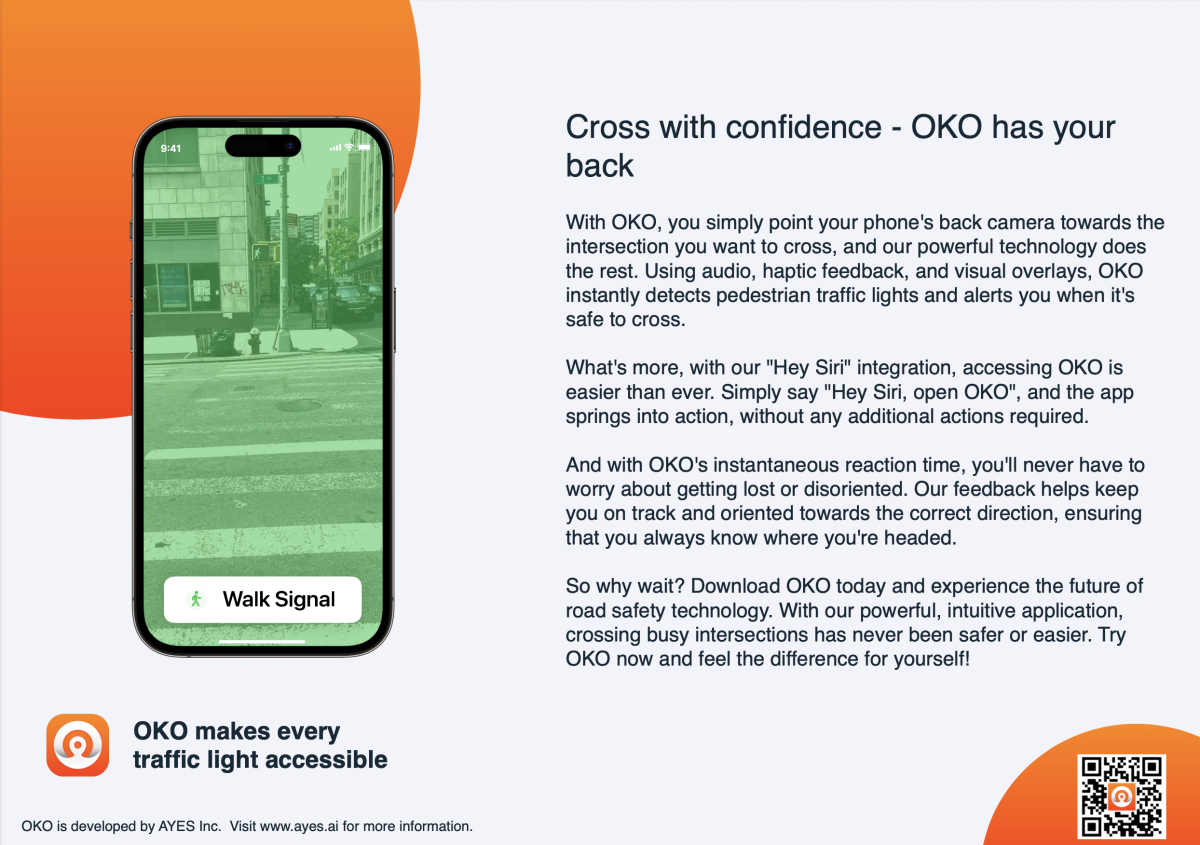Initiative details
Our main product - a mobile app called OKO - makes every pedestrian light accessible to blind and low vision pedestrians. Cities all over the world struggle with making their pedestrian lights accessible by installing an audible signal. Physical audible signals have multiple challenges: they cost up to €50.000/intersection, they produce a lot of noise pollution and hence neighbours complain, they often brake, it's cumbersome to maintain them, they are not 24/7 operational due to noise pollution, etc.
OKO provides blind and low vision pedestrians with a handheld audible signal through their smartphone. OKO uses the back camera and AI to identify the pedestrian signal status. Differentiable audio, haptic and visual feedback is being used to convey that status. OKO doesn't rely on additional infrastructure to be installed and doesn't rely on a WiFi nor cellular connection. We provide blind and low vision pedestrians to safely cross the street with more ease and confidence. Our technology is game changing the market in many ways.
OKO provides blind and low vision pedestrians with a handheld audible signal through their smartphone. OKO uses the back camera and AI to identify the pedestrian signal status. Differentiable audio, haptic and visual feedback is being used to convey that status. OKO doesn't rely on additional infrastructure to be installed and doesn't rely on a WiFi nor cellular connection. We provide blind and low vision pedestrians to safely cross the street with more ease and confidence. Our technology is game changing the market in many ways.
Initiative date
to
Who was/is your target audience?
Policy makers
Public authorities
Children 0-16
Young adults 17-25
Adults
Parents
Seniors
Pedestrians
Topic
Create awareness
Education in school or in community organizations
Provide alternative solutions
Organisation details
AYES
Enterprise
Belgium
Antwerp
Contact name
Michiel Janssen
Telephone number
+32493689267
michiel.janssen@ayes.ai
Website link
Project activities
If you work together with external partners, list the most important partners and briefly describe their role.
NA
Please describe the project activities you carried/are carrying out and the time period over which these were implemented.
AYES is a young company developing the OKO application. In the beginning of our journey, July 2021, we started to develop the first version of OKO. Throughout a period of 5 months we co-developed OKO together with a couple of hundred blind and low vision pedestrians to make sure that our reliability, usability was perfect. In January 2021 we launched OKO into the market and was an immediate hit. As of today we are still improving OKO in terms of the user experience as well as the functionalities.
OKO has an exclusive functionality in Belgium where we also help people get on public transport. Similarly to recognising the pedestrian signal, we inform you which bus is in front of you when waiting at a bus stop. The camera input is being used to identify the bus and through audio cues we will inform you the bus line number and destination. Again we don't rely on any chances to current infrastructure making at a very scalable technology.
OKO has an exclusive functionality in Belgium where we also help people get on public transport. Similarly to recognising the pedestrian signal, we inform you which bus is in front of you when waiting at a bus stop. The camera input is being used to identify the bus and through audio cues we will inform you the bus line number and destination. Again we don't rely on any chances to current infrastructure making at a very scalable technology.
Evaluation
What has been the effect of the activities?
In the past year OKO has helped cross 600.000 intersection, and currently we help safely cross 5.000 intersections per day. Imagine what could have happened at those intersections when OKO wasn't there to help...
Please briefly explain why your initiative is a good example of improving road safety.
Crossing the street as a blind or low vision pedestrian is one of the hardest challenges there is. We provide a very easy, scalable solution which they can rely on anywhere, anytime.
How have you shared information about your project and its results?
We haven't publicly made any report. Our usage and increase of the safety of our users prove our immediate valuable impact.
Supporting materials
